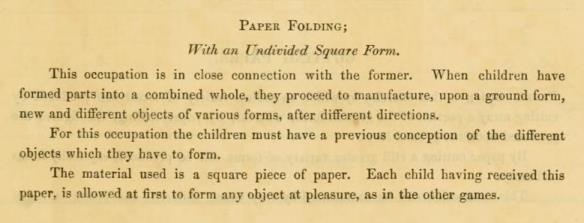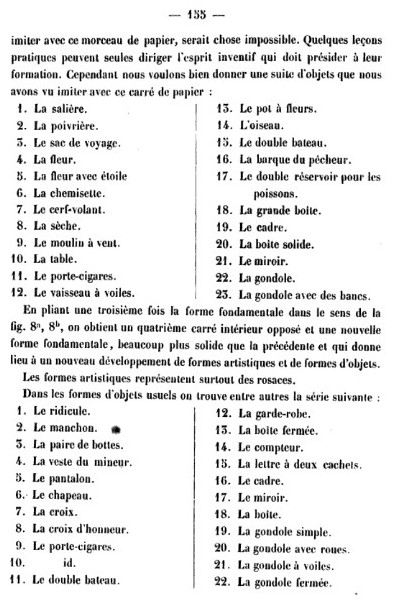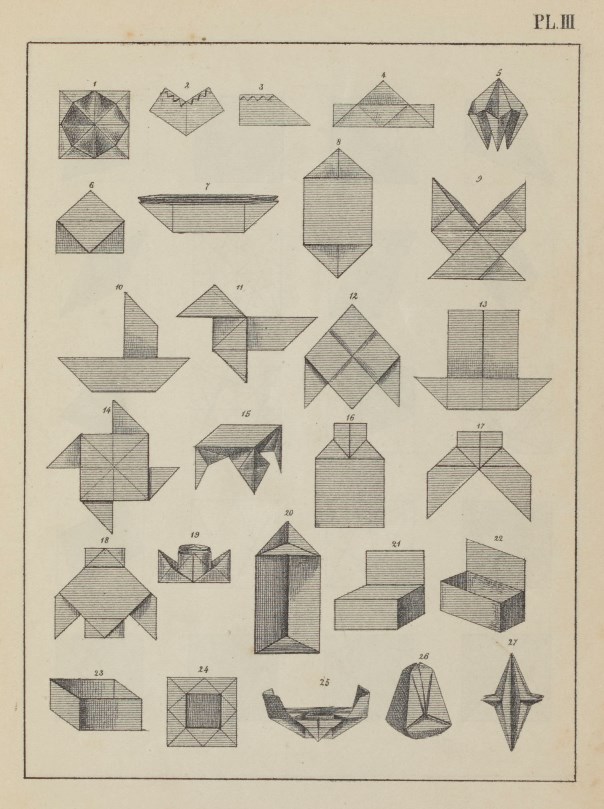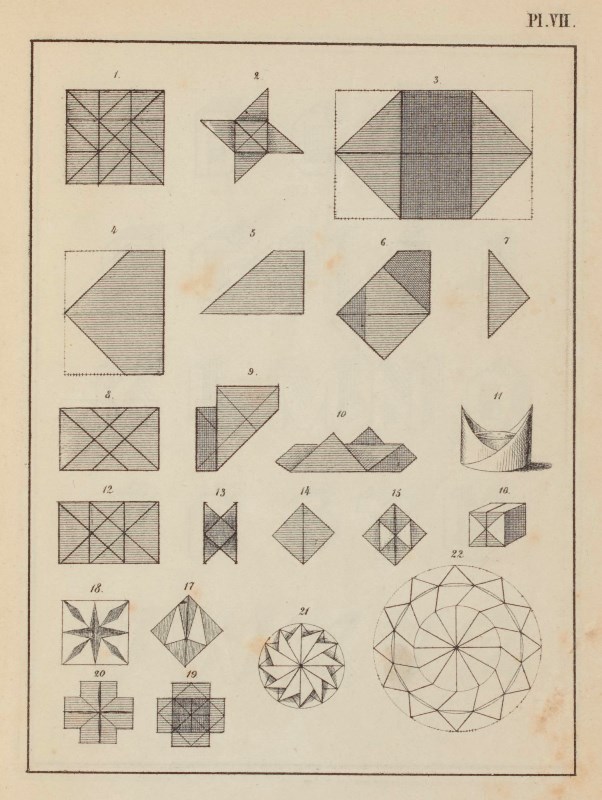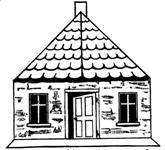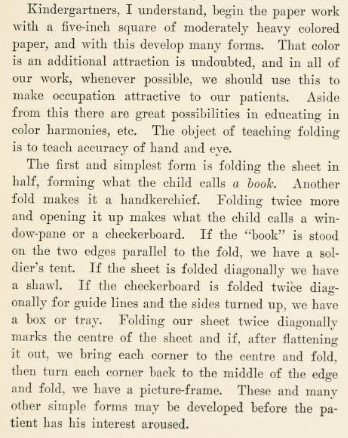| The Public Paperfolding History Project
Last updated 13/12/2023 x |
|||||||
| The Froebelian Occupation of Falten - Lebensformen (Forms of Life) | |||||||
| This
page is being used to collect information about Forms of
Life, which are part of the Froebelian occupation of
Falten. Foems of Life are paperfolds which represent
everyday objects, and which were taught / explored in the
Kindergarten as part of the Froebelian occupation of
Falten (paperfolding). Please contact me if you know any
of this information is incorrect or if you have any other
information that should be added. Thank you. This page gives the sources where publication of various lists, explanations and illustrations of the Froebelian Forms of Life can be found. Many of these designs will also have their own Individual Design page. There is a separate page for Simple Froebelian Folds of Life (ie those which which are not recorded on Individual Design Pages). ********** 1855 There is a brief list of some basic Forms of Life (though the term is not used), and some information on their use in the Kindergarten within the occupation of Paper Folding, in 'A Practical Guide to the English Kinder Garten' by Joh and Bertha Ronge, which was published by Hodson and Son in London in 1855.
********** 1859 Two lists of 'figures d'objets usuels' appear in 'Manuel pratique des jardins d'enfants de Frédéric Froebel', which was compiled by J F Jacobs and published by F Claassen in Brussells and L Hachette and Cie in Paris in 1859. The first list gives designs that can be developed from the Double Blintz Basic Fold and the Windmill Base, the second designs that can be developed from the Triple Blintz Basic Fold.
********** 1861 'Das Paradies der Kindheit' (The Paradise of Childhood) by Lina Morgenstern, which was published in Leipzig in 1861, contains a chapter on Das Papierfalten which briefly refers to 'Lebensformen' (Forms of Life)', and gives a list which translates as, roughly, 'Mirror, Salt Dish, a Table, Sailing Ship, two Barges, a Bird, two Boxes, a Bag, Flower Vase, Cup etc.' Unfortunately there are no illustrations of these forms. ********** 1863 'De Kleine Papierwerkers: Volume 1: Wat men van een stukje papier al maken kan: Het vouwen' (What one can make from a piece of paper Folding)' the first in a series of four books about Froebelian occupations written by Elise Van Calcar, was published by K H Schadd in Amsterdam in 1863. It contains the earliest references to and illustrations of many Forms of Life. Although the designs shown in Plates 3 and 7 are mainly developed from squares via the Double Blintz Basic Form, Windmill Base, Triple Blintz Basic Form and the Double Bookfold Basic Form, the range of Froebelian Forms of Life is extended by the inclusion of designs from squares developed via the Waterbomb Base, from the 9x9 grid and from oblongs.
Plate 7 shows, inter alia, three designs developed from oblongs.
********** 1869 'Der Kindergarten' by Hermann Goldammer, which was published by Habel in Berlin in 1869, contains a list of 'lebensformen' (Forms of Life) but says that, roughly, 'It is impossible to give an exact description of the manner in which they are folded'. The designs listed are developable from the blintzed square, the Windmill Base, the Double Blintz Basic Form and the Triple Blintz Basic Form. ********** 1880 'The Kindergarten Principle' by Mary J Lyschinska, which was published in London in 1880 by Wm Isbister Ltd, lists 46 forms of life, only some of which are illustrated. They are divided into three groups, or stages of objects, very simple and single blintz designs (see examples below), double blintz basic fold / windmill base designs, and triple blintz basic fold designs.
********** 1915 'Occupational Therapy: A Manual for Nurses' by William Rush Dunton, which was published by the W B Saunders Company in Philadelphia and London in 1915, contains a section on simple Froebelian Forms of Life
********** |
|||||||
